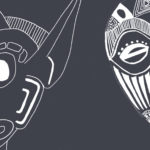The Inheritors is William Golding’s second novel, published just a year after Lord of the Flies. At first glance, these two books couldn’t be much more different: Lord of the Flies is about schoolboys stranded on an island, while The Inheritors documents the last days of the Neanderthals. However, both stories detail the battle for survival, the struggle of the human condition, and the terrifying results of a bloody war.
Golding considered The Inheritors his finest novel, and he wrote the first draft in an astonishing 29 days. He didn’t conduct a great deal of research into the Neanderthal people, but his vision has been proved to be remarkably astute. The biggest success of the book is the way he elicits sympathy, and empathy, from the reader, despite the fact that we are the ‘Inheritors’ – the Homo Sapiens responsible for the Neanderthals’ demise. This realisation comes towards the end and deeply shakes the reader.
The characters are a real highlight, and each have their own developed personality. ‘The people’, as they call themselves, barely speak, but they communicate through telepathic images, leading to the refrain ‘I have a picture’, which reverberates throughout. Much of the narrative is told through the eyes of Lok, who is a fun-loving, charming, and rather irresponsible male. He’s treated with affection, but also with irritation, by the other Neanderthals, particularly his partner Fa. Fa is one of Golding’s best characters; she’s fierce, inventive and brave. It is Fa who sets out to find ‘the people’ when they start disappearing, and it is she who realises the truth about the ‘New People’.
In the opening of the book, the people return to their cave after the winter. There is joy here: joy in the lighting of the fire and in the coming of Spring, which they attribute to their goddess Oa.
‘Everything had waited for them: Oa had waited for them. Even now she was pushing up the spikes of the bulbs, fattening the grubs, reeking the smells out of the earth, bulging the fat buds out of every crevice and bough.’
They are hungry after the winter, and set out to find food. The Neanderthals have a predominantly plant-based diet as they do not hunt. However, they will eat meat, despite not really liking the taste, as long as they haven’t killed it themselves. They find a deer which has been slaughtered by a sabre-toothed tiger, cook the meat and eat it. The patriarch of the group, Mal, is dying, but the people are satisfied with their food and shelter, and there is a quiet calm in the early stages of The Inheritors. However, Lok detects an unusual smell and when he is asleep, a noise comes from the waterfall. Their peace is about to be destroyed.
The invasion from the ‘New People’ begins with the disappearance of Ha, and the smell of an other on the cliff. The Neanderthals are confused – ‘There is no other in the world’ and their sighting of the others only serves to heighten this confusion:
‘A piece of white bone was placed under their eyes, fitting close, and where the broad nostrils should have shown were narrow slits and between them the bone was drawn out to a point. Under that was another slit over the mouth, and their voices came fluttering through it. The eyes of the face that peered through all this bone were dark and busy.’
Golding is describing human features, but such is the brilliance of this narrative that the homo sapiens feel ‘incomprehensibly strange’, both to the Neanderthal people, and to us, the reader. Our familiarity with our own faces means that we never really think about their construction. Humans are ‘other’ for the majority of this novel, and this places us in a uncomfortable position as the perspective shifts near the end of the book, and we finally ‘see’ Lok:
‘The head was set slightly forward on the strong neck that seemed to lead straight on to the row of curls under the lip. The mouth was wide and soft and above the curls of the upper lip the great nostrils were flared like wings. There was no bridge to the nose and the moon-shadow of the jutting brow lay just above the tip.’
The devastating fight at the conclusion brings to mind Jack and his hunters’ pursuit of Ralph in Lord of the Flies. Lok and his family struggle against the weapons of the ‘New People’, and they cannot understand why this attack is happening to them. Unfortunately for Lok, there isn’t a Naval Officer, or anyone else, who can come to his rescue.
The Inheritors is a remarkable novel, emotional, intense, and moving. It is also full of beautiful descriptions, and I’ll leave you here with one of my favourites:
‘Out of the firelight everything was black and silver, black island, rocks and trees carved clearly out of the sky and silver river with a flashing light ripping back and forth along the lip of the fall. All at once the night was very lonely and the picture of Ha would not come back into his head.’


